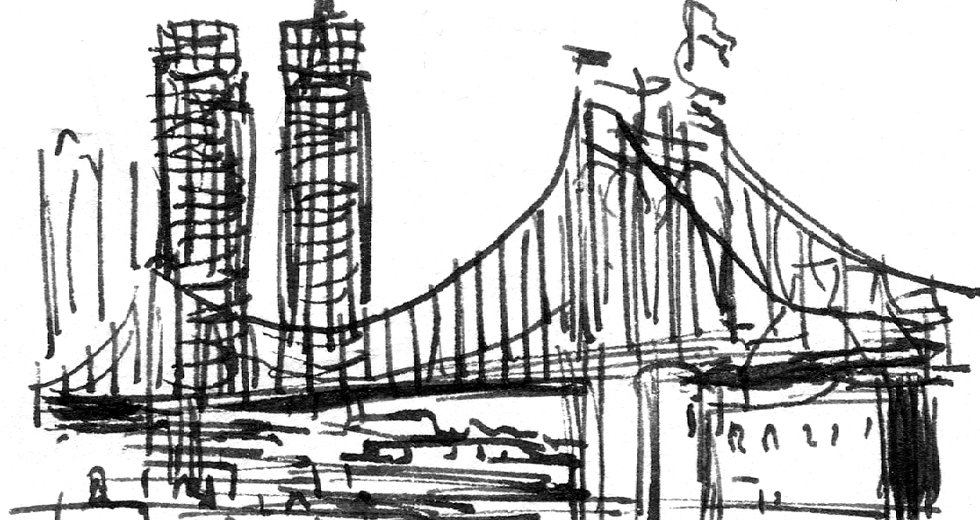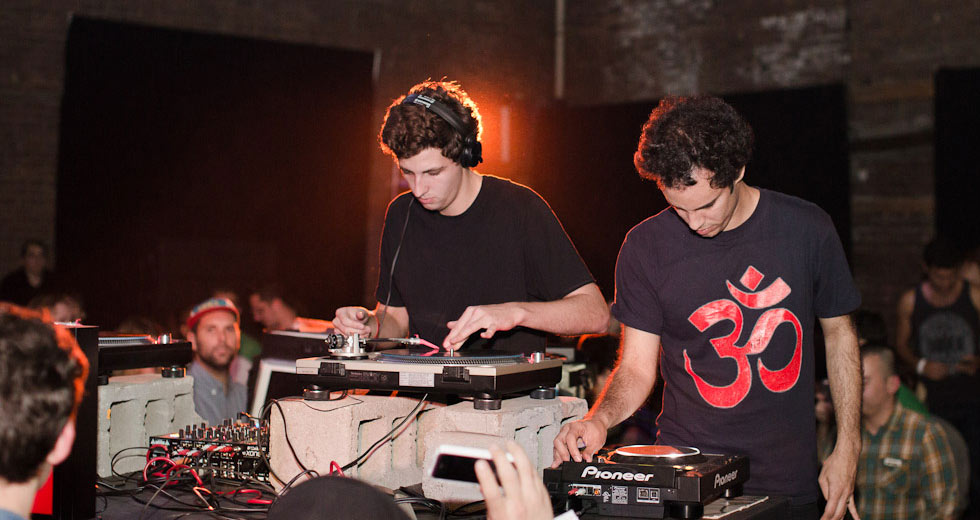Nightclubbing: New York City’s Pyramid Club
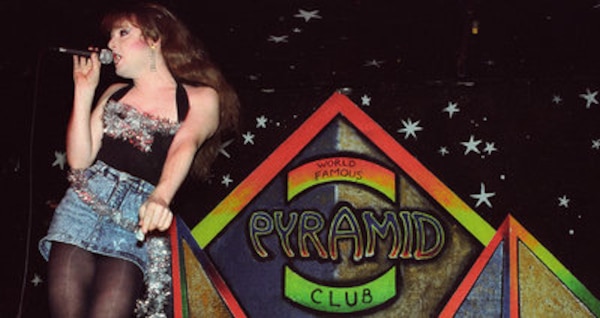
An oral history of the New York space that served as the stomping ground for influential performance artists, musicians and drag queens like John Kelly, Larry Tee, Antony Hegarty of Antony and the Johnsons, RuPaul and Lady Bunny.
In December of 1981, a seedy old Polish bar on Avenue A and Seventh Street, situated across from Tompkins Square Park, celebrated a grand reopening. Though it was small and divey, The Pyramid Club would soon become a cornerstone of the East Village underground art and performance scene that attracted New York’s cultural elite in the mid-’80s. During those years, Keith Haring, Andy Warhol, and Madonna, could be seen amidst the crowds who ventured to the Wild Wild East to watch the depraved and inspired performances happening within the Pyramid’s walls.
It served as a safe haven for freaks, geeks, weirdos, queers, and dreamers to come together and create.
Under the watchful eye of Alan Mace, Bobby Bradley, Vincent Sapienza, and Brian Butterick (who later took over the club), the venue and its performers would give birth to the renowned drag festival, Wigstock, host the first New York performances of bands like the Red Hot Chili Peppers and Nirvana, and serve as a stomping ground for influential performance artists, musicians and drag queens like John Kelly, Larry Tee, Antony Hegarty of Antony and the Johnsons, RuPaul and Lady Bunny.
And though many of its most infamous performers like Tabboo, Hapi Phace, and Ethyl Eichelberger, never gained worldwide fame or recognition, their near nightly presence influenced the city’s underground club culture for decades to come. The Pyramid Club came along at the right time – just before the AIDS crisis shook the city and gentrification pushed artists out of the East Village. It served as a safe haven for freaks, geeks, weirdos, queers, and dreamers to come together and create. Sometimes it was bad; sometimes it was beautiful. But it was never boring.
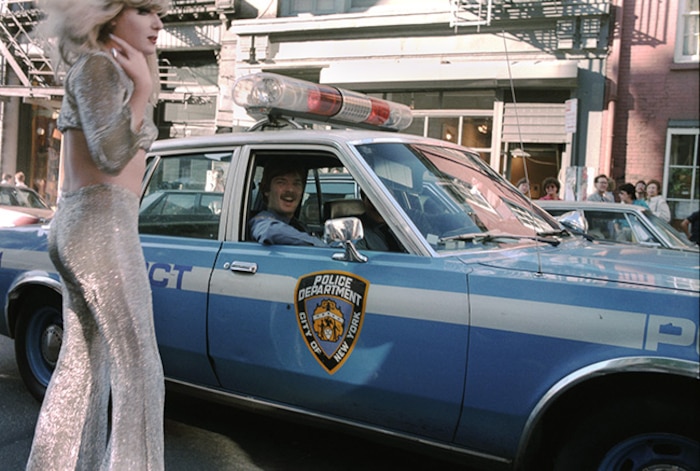
John Kelly, performance artist
The Pyramid Club opened in December of 1981. I actually performed the night it opened. I was 22?
Brian Butterick (AKA drag queen Hattie Hathaway), manager of the Pyramid
[The first night] I was a humble customer. I worked at the Mudd Club. I was living in the neighborhood and I walked by a couple of days before and they were doing some work on it, and I was like, “I can smell something’s going on here.” And I went in and asked and they were like, “Oh, we’re opening a new club. Come, here’s the invite.” I came and I was blown away.
John Kelly
I performed “The Martyrdom of Saint Sebastian.” He’s considered the gay patron saint because he was shot with arrows by soldiers and I guess the arrows were a metaphor for penetration. I had an upside down-like bustier on, but my chest was exposed and I had a teased out red wig and black eye sockets. So it was kind of like glamorous punk drag, glamorous gender-fuck punk drag. And then the arrows were actually sounds that I reacted to physically. I did a front flip over the railing, and that’s how I died at the end.
Brian Butterick
It was a really rundown Polish bar. The kind where old Polish men would come in for their 50 cent shots at 9 in the morning. The owner of the building was this guy named Richie Hajguchik. The bar wasn’t doing well and when they [Bobby Bradley and Alan Mace, John Tucker, and another guy named Vincent Sapienza] all walked in, he heard cash registers ringing in the back of his mind so he said yes. Then before a few weeks had passed by, Richie was like, “Do you want to do every night?”
Make-up tricks from Ethyl Eichelberger. I really did learn from the best.
Paula Swede (nee Sjunneson), go-go dancer-turned-burlesque performer and producer
I was 22 in 1982. I was going to ITC, the International Center of Photography, studying photography and I was there that summer and I was just wandering round the East Village and stumbled into the Pyramid Club and took photos. It was their six-month anniversary and the club caught on fire. I took pictures of a lot of the Trockadero people on the fire truck, like John Kelly, Ethyl Eichelberger and Larry Ray – all the old school drag queens – and I fell in love with them. I was just like, “Who are you? You’re fabulous.” Tanya Ransom – that’s who I ended up marrying and having a child with – was an institution at the Pyramid Club. I think (he) was the first person who did drag that was like Nina Hagen, total punk rock drag, sang, and wrote songs. Tanya Ransom inspired John Kelly to do drag. They were very good friends.
John Kelly
I met Tanya Ransom at the Anvil. Well, Tanya was lip synching Nina Hagen. I was at art school, and I would go there and just sketch all night, and I fell totally head over heels for Tanya. Tanya and the other queens at the Anvil used to dance on the bar of the Anvil, so Tanya and I decided to start that at the Pyramid Club one night.
Paula Swede
I used to get up on the bar and dance, and finally Bobby Bradley, who was the manager of the club, he just finally hired me because he felt it was the only way he could control me!
John Kelly
So you walk in the Pyramid Club and you see these drag queens and other creatures dancing on the bar and that was a great, you know, first thing to see when you walk into a club. Ethyl Eichelberger, Larry Ray, who was the founder of the Trockadero Ballet, you know, hustler types. It was not just female drag, it was all sorts of drag.
Paula Swede
Ethyl Eichelberger taught me how to wear three sets of false eyelashes at a time. It’s like what Dietrich would do, too. You line your eye in white, and then you go underneath the lower line to extend the shape of your eye. Then you use black outside of it and it makes your eyes that much bigger. Make-up tricks from Ethyl Eichelberger. I really did learn from the best.
John Kelly
It was everything. It was gay, it was straight, it was punk, it was rock and roll, it was drag. I mean the drag was just a part of it. Early on, it was very kind of renegade performance art, punk, rock and roll mixture.
Paula Swede
It was an art bar! And a lot of great theater was happening there. Wendy Wild was a huge part of Pyramid Club.
John Kelly
It was just all mixed up, which was great.
Brian Butterick
I took over in early ‘82, maybe February. And then because I lived in San Francisco and was involved with all those punkers as well as New York and Los Angeles. I knew all these bands so I decided I was going to do a band night on Tuesdays, with live music.
Larry Tee
They would do these ridiculous shows with Lypsinka and Ann Magnuson. Even David Wojnarowicz, you know the gay artist? He had a group called 3 Teens Kill 4 that I remember seeing that was a noise collage band. It was just like all the best talent in New York was funneled through this one club.
John Kelly
Jack Smith – he is kind of the father of performance art. He made a very famous film called Flaming Creatures in 1963. Andy Warhol ripped him off. He was a genius but he only finished one film. He was a filmmaker, photographer, performer. I saw him perform one night at the Pyramid Club.
Paula Swede
The first time I saw GWAR was at the Pyramid Club. Lydia Lunch used to perform there all the time. She was my neighbor for a summer.
Larry Tee
It would be like the Butthole Surfers or all these cool bands to bring the early crowd in to make money that way. And then they would roll it into a nightclub afterwards and then they would have drag shows, or performance shows, or Blacklips where Antony (of Antony and the Johnsons) got his start. It was just absolutely a cauldron of talent.
Brian Butterick
Flipper, Fear. I don’t know, everything. Culminating in the Red Hot Chili Peppers’ first New York appearance. It must’ve been in ‘82. They were packed because there was a buzz out on them and it was the one where they used to close the show wearing only a sock on their genitals. They were actually Santa Monica Boulevard working boys. You know, hookers a lot of them. And so they were totally hip to the gays and enjoyed that whole tease.
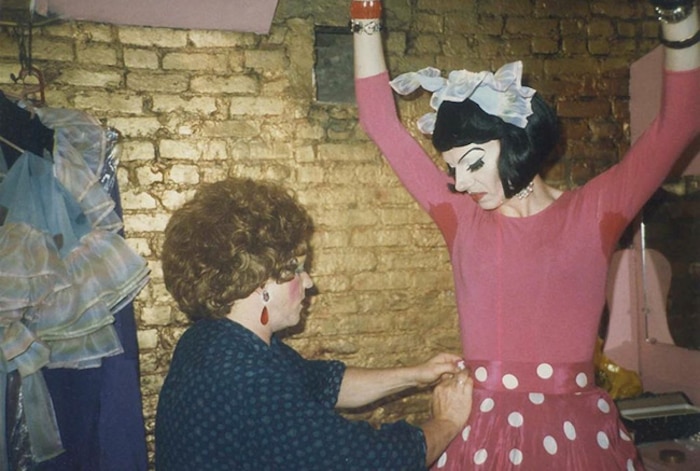
Michael Musto, longtime gossip columnist for the Village Voice
Sometimes they had folding chairs like it was a real theater. East Village variety… I went to see fun shows by Lypsinka, who’s John Epperson, he did a spoof of Valley of the Dolls, and you would see people like Flloyd, Hapi Phace, Tabboo, those were the hot performers of the moment. And if you look at them now, they’re such a long way from the kind of refined drag that has made it to television on the RuPaul show. Even though RuPaul was one of the ’80s queens.
Linda Simpson, a drag performer who threw a party at the club in the ’90s
Certainly I was a big fan of Whispers which was the Sunday night gay party. It was hosted by Hapi Phace. It was sort of a reaction to stuffy drag, which sort of was old school drag.
Brian Butterick
Sunday night was – it is no longer – but it was the gay night to go out. We used to joke because they’re all hairdressers and florists and they’re closed on Monday. And theater folk. You know, theaters are dark on Monday.
Paula Swede
Tabboo was kind of born in the loft (above the Pyramid Club) on a psychedelic trip. He was just this quiet, Armenian dude, a gay dude, he was a painter, and he took LSD and Tabboo was born and was unstoppable. Tabboo would sing and do monologues. A lot of Tabboo’s performances also looked like Tabboo’s paintings.
John Kelly
I saw Ethyl Eichelberger do a performance about Catherine the Great. Ethyl was a classically trained actor who did these different drag persona and also male persona as well. It wasn’t just women. He did mostly women but he could create tragedians and Nefertiti, Clytemnestra, and Catherine The Great. Larger than life women.
Paula Swede
Dean Johnson was there. Lady Bunny, RuPaul, Ann Magnuson, Joey Arias. Kembra Pfahler used to perform there all the time. Antony and the Johnsons, so many roots go back to the Pyramid Club. People heard about the Pyramid Club, and they would get in their fucking car or get on a bus and come to New York and be like, “Okay, I’m here.” Freaks from everywhere.
Larry Tee
That was the first trip we made to New York was with my group Now Explosion and we played at The Pyramid. Somebody said “Oh, the Pyramid Club is really cool,” so we sent a press package with a cassette of our stuff. Bad, bad, bad. So bad. How bad can it get baby? Totally unplayable, but, they really loved what we were doing.
Paula Swede
I remember the day that Now Explosion came off their bus from Georgia. Larry Tee, RuPaul and Lady Bunny. There was five or six. They literally spilled out of a bus, and they just stumbled in and they were amazing. RuPaul and I traded T-shirts. He used to do a little fanzine called New York Is a Big Black N*er. It was hilarious. He was wearing gaiter boots for fly fishing, little hot pants and a shirt, braids in his hair, so cute.
Brian Butterick
The first time I saw RuPaul he was in a band called Wee Wee Pole, it was so bad. He was doing an androgynous punk thing. He had a mohawk. Very little drag, but a little nod to drag in there. This was way before “Supermodel.” RuPaul was living in the basement of the Pyramid. And she was keeping her clothes in a bag in the coat check.
Lady Bunny was the queen of Pyramid, in my eyes anyway... I thought she was the perfect drag queen.
Larry Tee
We brought him to New York for the first time and he performed with us when he first came up. I remember the first time Ru did drag, that we were aware of. We made her be a bridesmaid for one of our wedding shows with Now Explosion. And when she showed up with her white hat and standing a head above all the other bridesmaids, you know, time stood still.
Paula Swede
The Now Explosion came with the person who would be calling themselves Lady Bunny. There was already a Bunny on the scene, Bunny Manhattan. Bunny Manhattan was totally pissed off that Lady Bunny was using the name Bunny.
Larry Tee
Lady Bunny did drag for the first time at one of my birthday parties and then we dragged her up to New York under the instructions that since she couldn’t drive, that she would have to at least entertain us by doing drag all the way up. And she was so furious at us, by the time we got up there, for making her hop out in North Carolina and pump gas and shit, that she never came back.
Brian Butterick
She started out as the office help in the daytime, believe it or not. We had to have someone answer the phone.
Miss Guy, drag performer and DJ, singer of the Toilet Boys
Lady Bunny was the queen of Pyramid, in my eyes anyway. I remember seeing Bunny perform really early on. It might have been my first time there, and I had just never seen anybody that sharp, and just so funny, and just great. She looked great, she sang great, she performed great. I thought she was the perfect drag queen.
Linda Simpson
The whole Wigstock aesthetic came out of Pyramid.
Brian Butterick
We bankrolled the first Wigstock and it cost us $1,000, which included the sound system from out of town, and a bribe to the Parks Department of $50. It wasn’t impromptu. The impromptu thing was getting drunk at the Pyramid and going into Tompkins Square Park and seeing the anniversary of Woodstock approaching, and then thinking, “Well, let’s do an outdoor festival. Let’s call it Wigstock,” and we were so drunk we can’t remember who came up with the name. It was probably Wendy Wild. It was the Fleshtones, me, Lady Bunny, Michael Oldman, and maybe even Baby Gregor, people who worked at the Pyramid. We didn’t really get much press for the first couple of years. It was all word of mouth.

John Kelly
The glory days of the Pyramid Club began when it opened in December of 1981 and for me, really, the East Village really started to change like, ’85, ’86, up to ’88.
Paula Swede
The East Village was still edgy. Art galleries [were] springing up everywhere. Graffiti was really starting. People were starting graffiti and hip hop, like break dancing. There was so much that was going on culturally, it was all pre-AIDS. Everyone was hanging out together. Andy Warhol used to come to the Pyramid Club all the time. Marlo Thomas would come to the Pyramid Club. She loved hanging out with the drag queens. Madonna performed there.
Miss Guy
Avenue A, in those days, was sort of dangerous. It was kind of risky, walking around over there, in those days. Nobody lived over there, except artists and freaks.
AIDS had a very slow insidious build and then it clobbered the community. It utterly devastated the scene.
Paula Swede
There was a lot of drug abuse at the Pyramid Club which probably wasn’t as tolerated other places. Bobby would just lock himself up in his office and shoot up and make anonymous phone calls, just pick up the phone and dial numbers and talk to people around the world. “Hi, this is Bobby. I’m at the Pyramid Club at 101 Avenue A. I’m in New York. It’s really cold outside. Oh, you’re in Tokyo?” It was one of his greatest joys.
John Kelly
The AIDS crisis was beginning in ’81, ’82 but it didn’t really even have the name AIDS until I think ’83 or something. It took awhile for the culture generally to realize what was going on and to know how the virus was transmitted. But basically it decimated, it killed off my generation. It killed off all these great artists. I lost my first partner in 1982 and it was just endless. Dave Wojnarowicz, Keith Haring, Rob Mapplethorpe, John Sex, it was just this endless number of artists who died and it was devastating to culture and to the community. So to me, AIDS, it was a very slow insidious build and then it clobbered the community. It utterly devastated the scene.
Brian Butterick
I remember this kid named Rusty, I don’t think I ever knew his real name, coming up to me with KS (Kaposi’s Sarcoma) lesions all over his body and asking if he could dance on the bar in his underwear, and I let him. I thought it was an amazing, wonderful thing. At that point AIDS was fatal and the guy was a very handsome lad and the fact that he had these lesions were like a badge of honor, like the Purple Heart. I felt he should be able to express himself that way.
I had some guy try to sell me an Uzi out of his trunk. Like, what would I do with an Uzi?
Paula Swede
If people weren’t dying of AIDS, people were ODing. That was when [Mayor Ed] Koch decided, “We’re going to clean up New York City” and he shut down all the methadone clinics, and then they went after shutting down all the places that were selling drugs. The East Village was a complete and utter police state. You would see people lying in doorways dead because the methadone clinics were closed and they couldn’t get their drugs.
Brian Butterick
I had some guy try to sell me an Uzi out of his trunk. Like, what would I do with an Uzi?
Paula Swede
Some people decided they just couldn’t deal with it, like Ethyl Eichelberger, who committed suicide. A lot of people checked themselves out. It was hard. It was awful. I couldn’t go back to New York for the longest time. It was just too depressing. I wouldn’t go into the Pyramid club. Too many ghosts.
Larry Tee
Everybody was wearing black. There was always a funeral.
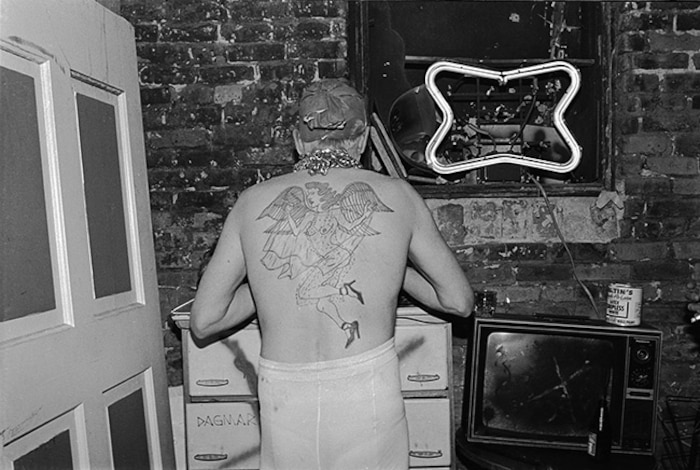
Linda Simpson
I felt that the drag shows served a bit as kind of like USO shows that would entertain the troops because, I think that anything having to do with gay or queerness back then, especially in the East Village, was kind of politicized, even if you weren’t embracing that entirely. I felt like drag queens were the cheerleaders in some way. It was a welcome relief, in some way, to have some comedy and to have some campiness going on.
Brian Butterick
Linda was the only one that kept the torches burning. That was good, and Linda’s always done great work and she’s always been sort of like an outsider artist.
Linda Simpson
I started doing a club there in 1990 which ran for about two-and-a-half years I think. Anyways, it was successful, but at that point when I got to the Pyramid it was faded. We did a show called “New Queens on the Block.” But there became a very intense media focus on drag in general. And especially on the New York downtown drag community.
Michael Musto
National glossy magazines were covering the arts scene of the East Village and the performance arts scene.
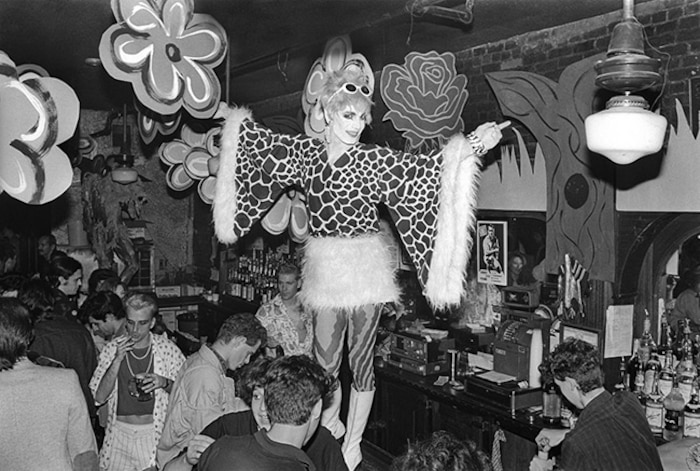
John Kelly
Once the major media started covering it, and all the original artists started to get really famous, the focus then shifted to the clubs and whatever performance was happening in clubs.
Michael Musto
So it was bound to implode because, by necessity it had to be a ramshackle, kind of anti-establishment type of set up. And the more attention it got, the more doomed it was.
Paula Swede
Everything is driven by economy now. I feel like that’s one of the few places I showed up at the right place at the right time.
John Kelly
It was one of those rare moments where the combination of affordable rent and like-minded spirits can make for an incredible scene.
Brian Butterick
It was everything I always wanted to do. It was a gay-run club that adored women. It was a mixture of loud rock and roll and dancing and performance art. And drag queens.
Michael Musto
It was just a comfortable den where you could run wild. I’m not saying it was great every night, or that the shows were always fantastic, sometimes they were painful to watch. But it was a place where performers could experiment and go too far and learn their craft in front of an audience. Even if it was five people. And when the shows clicked, they were truly magical.
This feature is part of a week of articles guest curated by Levon Vincent. Says Levon, “Fashion and music in New York is totally symbiotic, and it has always been that way. It continues to today, even when you look at A$AP Rocky and guys like that. I used to work for the designer Pat Field, and we would go to the Pyramid because Sugar – who worked in the dressing room at Pat Field – also did security for Karen Black. I remember Larry Tee and Lahoma. They did a regular show, too.
That was a great period in New York history. But it was also a tough one. Everyone in New York City seemingly got AIDS overnight in the ’80s. A lot of people that I really looked up to were dying at that time. I’m not a native of New York or anything but I was lucky to move there when I did. I was part of that final Downtown generation, the period at the end of that sentence. Anyone who moved there even two years later was out in Brooklyn or the other boroughs. That’s a huge source of pride in my career.”
To check out more of the features that Levon Vincent picked out, check out his guest curator hub page.
Header image © Lynn Grabowski
